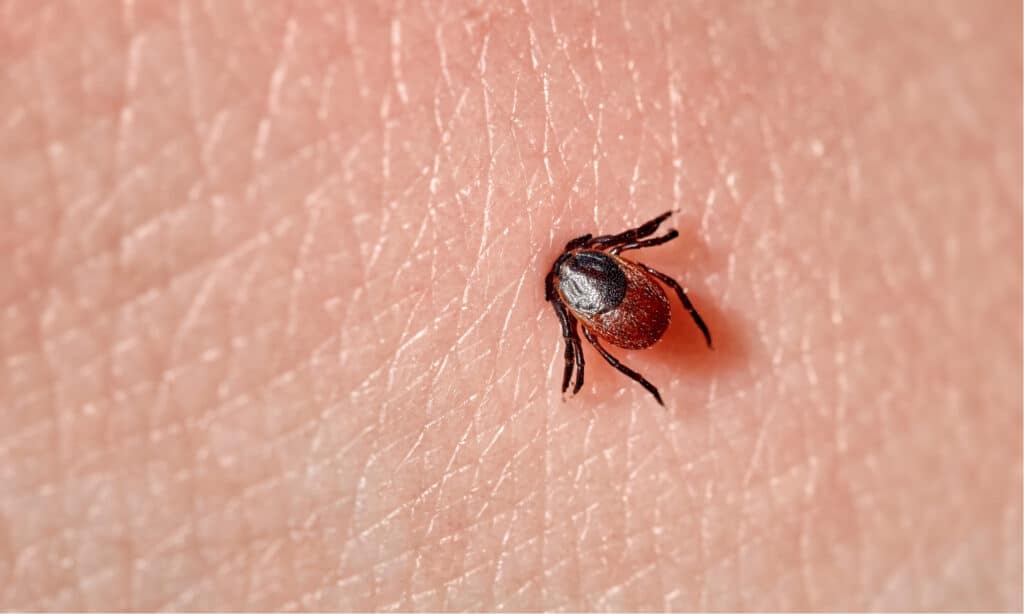Besides being major targets for hunters, deer are at risk of developing multiple diseases. However, they are more susceptible to becoming ill in the wild, as commercial deer populations are regularly checked and vaccinated if vaccines are available.
Unfortunately, many diseases deer can suffer from cause severe symptoms and may even kill the animal. Keep reading to learn about ten illnesses that can affect deer.
1. Chronic Wasting Disease (CWD)

Chronic wasting disease is a transmissible illness that can affect deer only.
©Amy Lutz/Shutterstock.com
Chronic wasting disease is a transmissible illness that can affect deer only. It’s a transmissible spongiform encephalopathy that affects the deer’s brain and nervous system. That’s why it is sometimes called “zombie deer disease.” It is caused by a misfolded protein called prion, which can be found in the central and peripheral nervous systems. This misfolded protein can modify the form of a normal prion protein. Symptoms of this illness include:
- Behavioral changes, like less interaction with other animals or nervousness
- Movement difficulties
- Weight loss
- Repetitive walking in set patterns
- Excessive salivation
- Teeth grinding
- Loss of fear of people
- Increased drinking and urination
While there’s still no 100% accurate statement indicating how this illness is spread among deer, some studies show that prions are found in excrements, absorbed in the soil, and eventually spread to other deer through the grass.
2. Epizootic Hemorrhagic Disease (EHD)

Epizootic hemorrhagic disease primarily affects white-tailed deer but has also been detected in elk and mule deer.
©iStock.com/Mickilu
Epizootic hemorrhagic disease primarily affects white-tailed deer but has also been detected in elk and mule deer. This infectious disease is caused by an Orbivirus virus, primarily Culidoides variipennis. The illness damages deer blood vessels, causing multiple hemorrhages. It can have three forms – peracute, acute, and chronic, the first two being the deadliest.
A deer infected with EHD will have symptoms like appetite loss, excessive salivation, fever, unconsciousness, blue tongue caused by lack of oxygen, weakness, tongue ulcers, bloody nasal discharge, respiratory issues, and lymph node enlargement, among others. Deer with chronic EHD may also have broken hooves, while bloody nasal discharge, excessive salivation, and skin hemorrhages are primarily symptoms of the acute EHD form.
3. Cutaneous Fibromas
Cutaneous fibromas are commonly called deer warts. They are found in wild and domestic deer and are caused by papillomaviruses or poxviruses. Most infected deer are young and usually get warts before they turn two years old. Warts can be transmitted through insect bites or if a deer comes into contact with contaminated objects. However, they cannot be transmitted to other livestock.
This disease is common in fallow deer, mule deer, red deer, white-tailed deer, roe deer, moose, caribou, and sika deer. The only way to establish whether a deer has cutaneous fibromas is to check its skin. If you notice fleshy wart-like growths, it most likely has deer warts. They can either grow alone or in clusters, and their size varies.
The good thing is that deer warts do not cause other health problems, and infected deer can be perfectly healthy as long as the warts aren’t in sensitive zones.
4. Brucellosis
Brucellosis is one of the animal diseases that can be transmitted to humans through unpasteurized milk, close contact with animal secretions, or undercooked meat. It can affect cattle, goats, sheep, bison, dogs, elk, caribou, and pigs.
Although it’s more common in cattle than deer, it has been identified in Cervus canadensis (elk or wapiti), Rangifer tarandus (caribou), and Alces alces (moose). In fact, a study shows that bison and elk are the only remaining “reservoirs” for the disease in the United States. They are located in the Greater Yellowstone Area.
5. Parasite Infection

Deer can get infected with over 100 internal or external parasite species.
©Evgeniyqw/Shutterstock.com
Deer can get infected with over 100 internal or external parasite species. These include flukes, nematodes, tapeworms, protozoans, and arthropods. In the United States, deer in southeastern states are at a higher risk of infection because the parasites are extremely diverse there.
The most common infections are with external arthropods and internal nematodes. In the southeastern states, the large lungworm, large stomach worm, and liver fluke are the most infectious. The lungworm is more common in young deer.
Deer can also get meningeal worms by accidentally ingesting slugs or snails while foraging. These worms can cause serious neurological and behavioral issues. Other parasites deer can get are Sarcocystis, larval tapeworm, arterial worm, nasal bots, and muscle worms.
As for arthropods – deer can get ticks, lice, bot flies, and deer keds. Heavy tick or biting fly infections during summer can cause major blood loss and affect the deer’s body.
6. Q fever
A study shows that deer can also get the Q fever disease called query fever. It is caused by the Coxiella burnetii bacterium, which can infect humans and animals. Besides deer, it’s common in cattle, sheep, cats, dogs, and goats.
The study focused on 79 roe deer from the Netherlands. Eighteen deer tested positive for Coxiella burnetii. This research was conducted after the 2007 Q fever epidemic among humans in the Netherlands, which was attributed to dairy goats and dairy sheep. However, as the scientists confirmed, roe deer may have also contributed to the epidemic.
In ruminants, including deer, Q fever primarily affects their reproductive systems, causing abortion, infertility, and stillbirth. It is also believed that animals that aren’t pregnant show no symptoms of being infected by Q fever.
7. Leptospirosis
Leptospirosis is yet another zoonosis disease, meaning it can occur in both animals and humans and can be spread from one to another. It is caused by the Leptospira bacteria. Deer can get this disease by eating grass or drinking water contaminated with infected urine from other animals. Leptospirosis symptoms in deer may include:
- Tiredness
- Jaundice
- Swollen kidneys
- Red blood cells in urine
- Reduces growth
- Corneal opacity
- Photosensitization
- Anemia
Fortunately, there’s a vaccine available that prevents infection. It can also help if the deer is already infected.
8. Tuberculosis

Deer can get tuberculosis by coming into direct contact with respiratory secretions from infected animals.
©Suvorov_Alex/Shutterstock.com
Tuberculosis can occur in most mammalian species. It’s a progressive and fatal disease that causes symptoms like coughing, weight loss, enlarged draining lymph nodes, and labored breathing. Small, firm lumps may appear inside the chest cavity, abdominal cavity, or lungs. Deer can get tuberculosis by coming into direct contact with respiratory secretions from infected animals.
Fortunately, humans suffer from a different type of tuberculosis, and scientists believe people can’t get the tuberculosis that affects deer. Eating well-cooked deer meat shouldn’t be a problem, even if it were transmissible. However, avoiding eating deer brain, spleen, spinal cord, or lymph nodes is recommended.
9. Bovine Malignant Catarrhal Fever
Bovine malignant catarrhal fever is a fatal disease caused by ruminant gamma herpes viruses. While it’s primarily found in cattle, it has also been identified in deer, buffalo, and antelopes.
Pere David’s deer is considered the most susceptible to this infection. Most deer suffering from this disease die within 48 hours after the first symptoms appear. Bison, on the other hand, can survive up to three days, while cattle a week or more.
Symptoms of malignant catarrhal fever include discharge from the nose and eyes, depression, fever, lymph nodes swelling, opacity of the corneas, diarrhea, and buccal cavity lesions. Moreover, infected individuals can become extremely sensitive to the touch.
10. Johne’s disease
Johne’s disease is also called paratuberculosis. It is a chronic and sometimes fatal infection found primarily in ruminants but identified in other animals like foxes, birds, and rabbits. The disease is caused by the Mycobacterium avium subspecies paratuberculosis bacteria. If a deer gets infected, the symptoms appear rapidly, and the disease progresses quickly. A study shows that Johne’s disease found in deer is much more serious than other deer illnesses, such as tuberculosis, yersiniosis, or malignant catarrhal fever.
Johne’s disease affects the ileum, the lower part of the intestine. The intestinal wall thickens, digestion is affected, and the body cannot absorb the required nutrients. Bacteria can be spread by eating or drinking contaminated food or water. Once infected, deer may show no symptoms for a long period until the disease is triggered by something like tough winters, social stress, or transport.
Up Next:
- What Do White-Tailed Deer Eat? 20+ Foods They Enjoy
- Epizootic Hemorrhagic Disease (EHD) In Deer: What You Need To Know
- Chronic Wasting Disease (CWD) In Deer: What You Need To Know About “Zombie Deer”
The photo featured at the top of this post is © iStock.com/Neil Bowman
Sources
- University of Missouri Extension, Available here: https://extension.missouri.edu/publications/g9489
- Washington State University, Available here: https://iacuc.wsu.edu/zoonoses-associated-with-deer/
- Europe PMC, Available here: https://europepmc.org/article/med/9704536
- Mayo Clinic, Available here: https://www.mayoclinic.org/diseases-conditions/brucellosis/symptoms-causes/syc-20351738
Thank you for reading! Have some feedback for us? Contact the AZ Animals editorial team.






